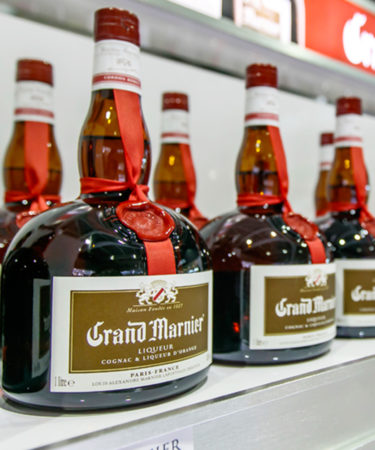
An orange-scented, Cognac-based spirit that packs a boozy punch, Grand Marnier means a lot of things to a lot of people. A Gallic liqueur with immense history, it is equally at home in a Margarita or canonical French dessert.
What should you know about the spirit too savvy to be called anything but “grand”? Here are 10 things to learn about Grand Marnier.
It’s a heavyweight.
While liqueurs like St. Germain, Mr. Black, and Von Humboldt’s Turmeric top out at 25 percent ABV, Cognac-based Grand Marnier is 40 percent ABV. That’s about 80 proof, and that’s as much as a lot of full-fledged spirits. (Tito’s vodka, Don Julio tequila, and Bacardi rum, for example, are 80 proof.)
Mr. Marnier was a real person.
The company was founded by Louis-Alexandre Marnier Lapostolle in 1880. His father-in-law, Jean-Baptiste Lapostolle, had established what Difford’s calls a “modest distillery” making fruit liqueurs outside of Paris in 1827. Louis-Alexandre came from a winemaking family in Sancerre and started out as an assistant to Jean-Baptiste’s son, Eugene. He had the then-revolutionary idea to pair Cognac with a then-exotic ingredient, oranges, in the Lapostolles’ laboratory years later. After 10 years of experimentation, Grand Marnier was born.
It’s Cognac, and then some.
Grand Marnier features brandy made from Ugni Blanc grapes from five Cognac crus, and is double-distilled in copper stills. It gets its orange notes from Caribbean-grown “Citrus Bigaradia,” also known as Seville or bitter orange.
Its tart will go on.
A bottle of Grand Marnier was reportedly discovered among the 5,500 artifacts salvaged from the 1912 Titanic wreckage.
Grand Marnier was and remains a family affair.
Founder Louis-Alexandre Marnier became Louis-Alexandre Marnier Lapostolle because he married Jean-Baptiste’s daughter. Today the company’s vice chair, Alexandra Marnier Lapostolle, is a member of la famille’s sixth generation.
Grand Marnier got by with a little help from its friends. One in particular.
Swiss hotelier and hospitality legend Cesar Ritz, founder of Paris’s Hotel Ritz and the forerunner of a little chain called Ritz-Carlton, was a friend of Louis-Alexandre’s and early adopter of Grand Marnier. He helped Louis-Alexandre come up with the name, bucking the trend at the time to call things “petit,” or little, as in the 1876 to 1944 local newspaper, Le Petit Parisien. Ritz also helped Louis-Alexandre come up with the bottle design, which was modeled after Cognac stills. And Ritz served Grand Marnier at the Savoy Hotel in London, where he was general manager.
It’s gone global.
In 2016 the Campari Group, a beverage conglomerate with Campari, Aperol, Wild Turkey, Skyy Vodka, and Appleton Estate among its 50-plus-label roster, acquired a controlling stake in the company that owns Grand Marnier, Société des Produits Marnier Lapostolle S.A., for a cool €652 million.
You can’t make a Sidecar without it.
Grand Marnier is an ingredient in the classic Sidecar cocktail, made with brandy, orange liqueur, and fresh lemon juice. It also features in a lot of bartenders’ Margaritas, and in lesser-known cocktails like The Marny and Moonwalk. The company politely reminds you that Grand Marnier is also very enjoyable sipped on its own or over ice, s’il vous plait.
It is famously flammable.
Grand Marnier is a key ingredient in Crêpes Suzette, an iconic French dessert made by topping a crêpe, or buttery pancake, with a citrus liqueur sauce (enter Grand Marnier) and flambéing it briefly. As legend has it, the dish was a happy accident created in 1895 when a young Monaco waiter, Henri Charpentier, accidentally lit a chafing dish on fire while serving dessert to the future King Edward VII of England.
Don’t call it un comeback.
Campari Group has big plans for Grand Marnier. Sure, that lofty purchase price included assumed debt, and was reportedly more than a tenth of the company’s market value. But chief executive Bob Kunze-Concewitz is unflappable, telling Reuters, “This is a great opportunity, like it was for the re-launch of Campari.” Kunze-Concewitz oversaw Campari’s growth from €957.5 million in sales in 2007, to €1,816 million in 2017. According to Reuters, Grand Marnier is now targeting cocktail bars in the United States with hopes of winning over bartenders in Brooklyn, N.Y., speakeasies. Weirder things have most certainly happened.
